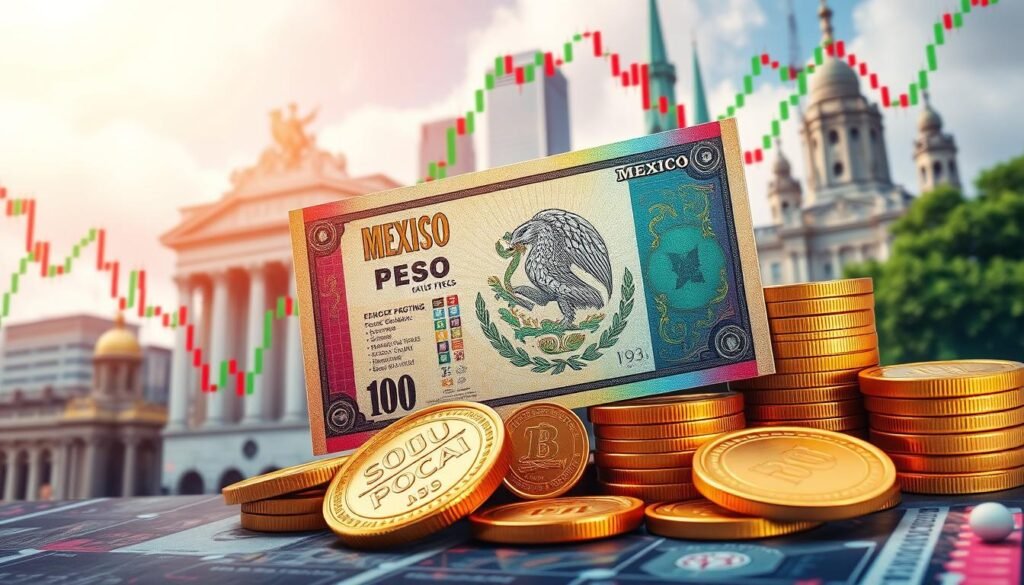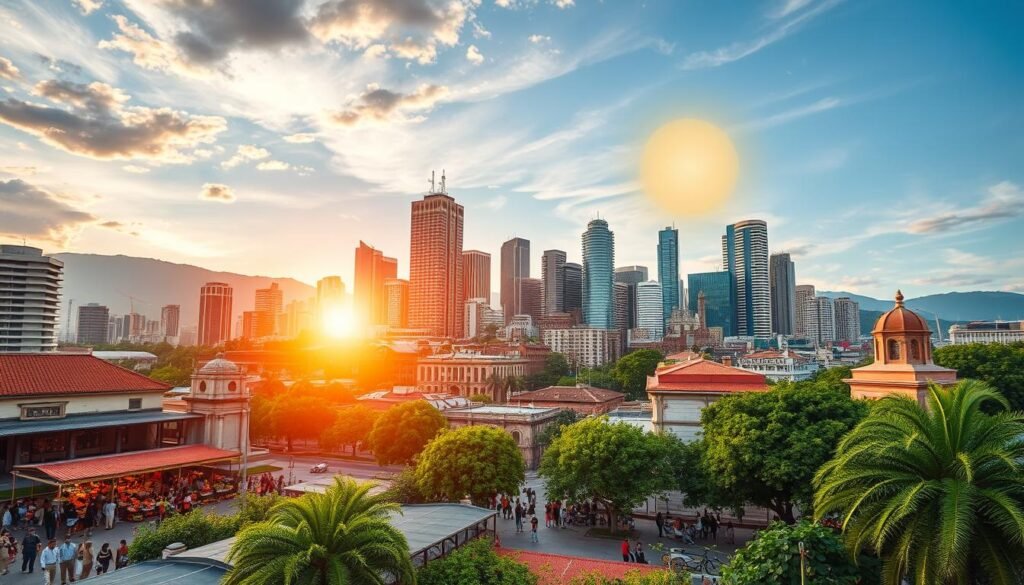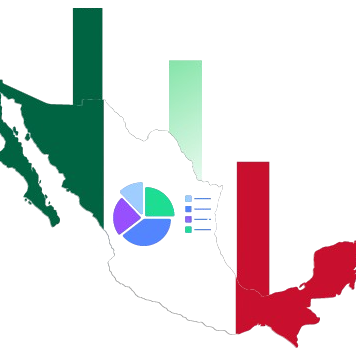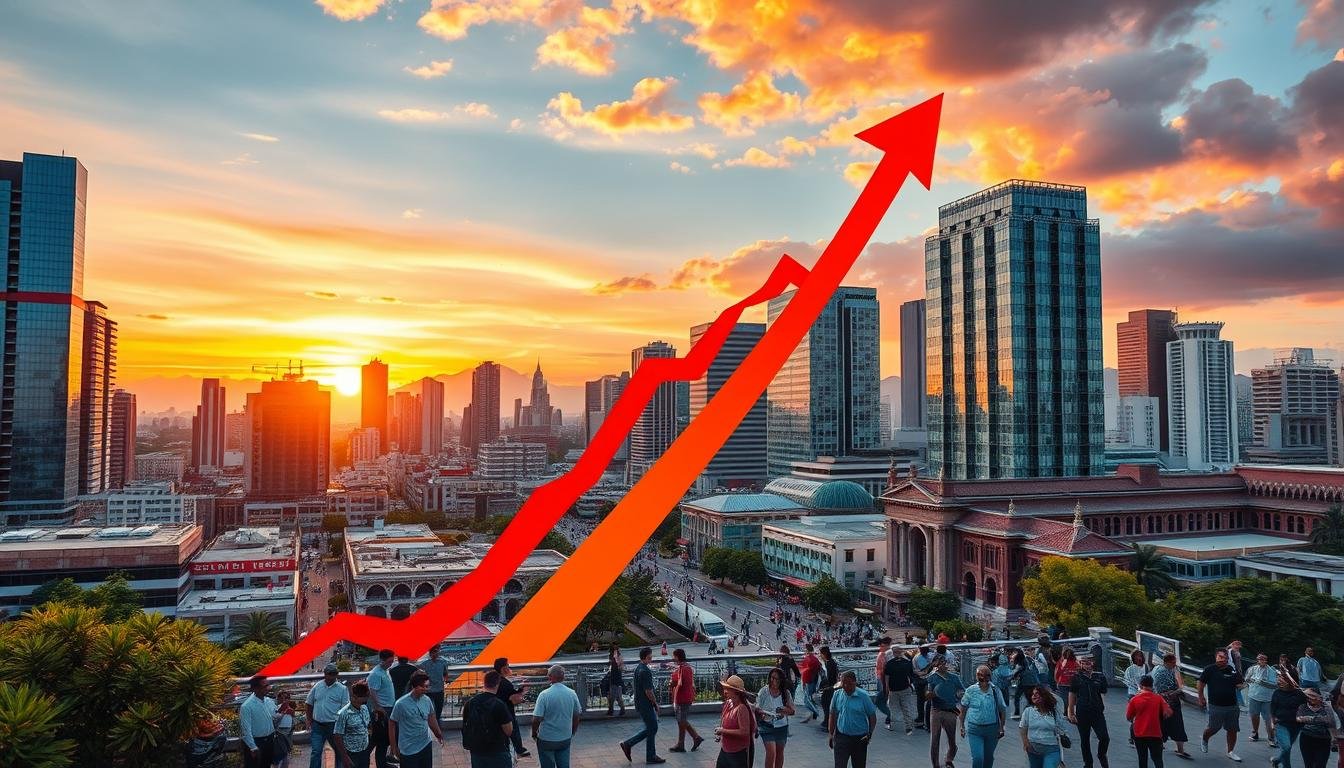Did you know Mexico’s economy is the second-largest in Latin America? It has a GDP of over $1.2 trillion. This emerging powerhouse is making big moves globally, becoming a key economic force.
Mexico’s main industries like manufacturing, agriculture, mining, and tourism are driving its growth. Its exports, from cars and electronics to food, are in high demand around the world. This is thanks to its economic reforms and free trade deals of recent years.
We’ll dive into Mexico’s economy more, looking at its natural resources, currency stability, challenges, and opportunities. Discover why Mexico is set to become a major economic player worldwide.
Key Takeaways
- Mexico’s economy is the second-largest in Latin America, with a GDP of over $1.2 trillion.
- Key industries include manufacturing, agriculture, mining, and tourism, with major exports such as automobiles, electronics, and agricultural products.
- Mexico has implemented economic reforms and free trade agreements to drive export growth and attract foreign investment.
- The Mexican economy faces ongoing challenges, including income inequality, corruption, and the need to diversify its economic base.
- Mexico’s natural resources, currency stability, labor force, and economic opportunities make it a rising power on the global stage.
The Rise of Mexico’s Economic Powerhouse
Mexico’s economy has grown stronger over the years, making it a big player worldwide. The Mexican GDP growth hit over $1.2 trillion in 2022. This growth is a big reason for its success.
Mexico’s Key Industries
Mexico’s economy is varied, with many strong sectors. Manufacturing is a big part, making up about 17% of GDP. It produces cars, electronics, and parts for aerospace.
The agricultural sector is also key, making up about 3.6% of GDP. It exports avocados, tomatoes, and coffee. The mining industry is vital too, focusing on oil and natural gas, which is about 5% of GDP.
The tourism industry is another big player. Mexico is a top spot for tourists worldwide.
| Industry | Contribution to GDP |
|---|---|
| Manufacturing | 17% |
| Agriculture | 3.6% |
| Mining (Oil and Natural Gas) | 5% |
| Tourism | N/A |
Mexico’s diverse and thriving industries have driven its economic growth. This makes it a strong economic force in the region and beyond.
Mexico’s International Trade and Economic Reforms
Mexico has become a big player in the global economy. It has done this by making international trade agreements and economic reforms. The country has grown its export markets and drawn in foreign investment.
A big step was joining the North American Free Trade Agreement (NAFTA), now the United States–Mexico–Canada Agreement (USMCA). This agreement has helped increase exports. The United States, China, Canada, and the European Union are Mexico’s main trading partners.
Mexico has also made many economic reforms in recent years. These include privatization, less government rules, and opening up industries to foreign investment. These changes have made the Mexican economy more modern and competitive.
These efforts show in Mexico’s economic growth. The country has seen steady GDP growth. Many industries now contribute to its economy, making it more diverse and lively.
Mexico is getting stronger in the global economy by improving its economic ties and making more reforms. It has a great location, skilled workers, and a growing market. This makes it a great place for businesses and investors.
Exploring Mexico’s Natural Resources
Mexico is a land full of natural wealth. It has many resources that have helped build its economy. These resources include minerals and agricultural products.
The mining industry is key to Mexico’s economy, making up about 5% of its GDP. The country is a big producer of metals like silver, copper, and gold. These metals help fuel the economy and make Mexico important globally.
Mexico’s diverse land and climate offer more than just mining resources. The agricultural sector thrives, leading in avocado, tomato, and coffee production. These are big exports. The country also has timber and freshwater resources that add to its economy.
Looking at Mexico’s natural resources, we see they drive the country’s growth. They support various industries and make Mexico a key player worldwide.
| Natural Resource | Contribution to Mexico’s Economy |
|---|---|
| Oil and Natural Gas | Accounts for around 5% of GDP |
| Precious Metals (Silver, Copper, Gold) | Significant export commodities |
| Agricultural Products (Avocados, Tomatoes, Coffee) | Key export items |
| Timber and Freshwater | Contribute to the overall economic landscape |
The Mexican Peso: Stability and Exchange Rates
The Mexican peso is a key part of Mexico’s economic growth. It has stayed stable in recent years, helping the economy and drawing in foreign investment. This stability comes from the Central Bank of Mexico (Banxico) managing the exchange rate well.
Market forces set the peso’s value, but Banxico steps in to control big changes. Even with ups and downs, the peso stays strong, helping Mexico fit into the global economy.
The peso’s stability has helped Mexico grow and develop. With a stable exchange rate, Mexico attracts foreign investment, boosts exports, and creates a safe space for businesses. This leads to more jobs, better living standards, and a brighter future for Mexicans.
Factors Influencing the Mexican Peso Exchange Rate
- Market forces of supply and demand
- Monetary policies implemented by Banxico
- Global economic conditions and investor sentiment
- Trade balances and current account dynamics
- Relative strength of the Mexican economy compared to its trading partners

The stability of the Mexican peso is vital for the country’s economic health and global financial standing. As Mexico grows stronger, the peso’s strength will keep playing a big role in its success.
fun facts about Mexico’s economy
Mexico’s economy is full of interesting facts that many don’t know. Let’s dive into some fun facts about this economic giant:
- Did you know that Mexico is the world’s largest producer of avocados? It makes over 45% of the world’s avocados.
- Tequila, a famous Mexican drink, plays a big role in the economy. Mexico makes over 300 million liters of tequila every year, bringing in billions of dollars.
- The Bolsa Mexicana de Valores, Mexico’s second-biggest stock exchange, is a key player. It has a market value over $450 billion.
- The Mexican peso is the most traded currency in Latin America. Every day, over $200 billion of it changes hands in the global market.
- Mexico is a big name in the car industry, making over 4 million vehicles yearly. It ranks seventh in the world for car production.
These fun facts highlight the wide range of Mexico’s economy. From farming to finance and industry, Mexico’s impact is vast. Exploring this country further shows its significant economic role.
| Sector | Contribution to GDP |
|---|---|
| Manufacturing | 17.4% |
| Trade | 16.7% |
| Real Estate | 13.9% |
| Transportation | 6.6% |
| Agriculture | 3.6% |
The Mexican Labor Force and Economic Challenges
Mexico’s labor force is key to its economy, with over 55 million people working in many fields. Yet, the country deals with issues like income inequality and social gaps. These problems need to be tackled for lasting growth.
Addressing Socioeconomic Disparities
Mexico has worked hard to cut poverty and better living conditions for its people. But, there’s a big gap between the rich and the poor. The government is trying to fix this with programs that improve education, healthcare, and jobs.
These efforts aim to make Mexico a fairer place. This way, the Mexican labor force can do well and help solve economic challenges in Mexico.
| Indicator | 2020 | 2021 | 2022 |
|---|---|---|---|
| Unemployment Rate | 5.1% | 4.8% | 4.2% |
| Poverty Rate | 43.9% | 41.2% | 39.6% |
| Income Inequality (Gini Coefficient) | 0.434 | 0.427 | 0.421 |
The table shows Mexico is making progress, with fewer unemployed and poor people, and less income inequality. But, there’s still work to do. The government’s ongoing support for the Mexican labor force and focus on inclusive growth is key.
Foreign Investment and Opportunities in Mexico
Mexico’s economy has drawn in a lot of foreign investment, playing a big part in its growth over the years. Its location, big market, and low labor costs make it a great spot for companies from around the world. This includes those in manufacturing, tech, and services.
Big names like Volkswagen, Samsung, and Nestlé have invested in Mexico. They come from the U.S., Europe, and Asia. The government has made it easier for foreign investment in Mexico by creating special zones and offering tax breaks.
Mexico is getting better at building its infrastructure and training its workers. This means more chances for foreign companies to make the most of its growing market and economy. Investors can use Mexico’s good location and its expanding middle class to their advantage.
Thriving Sectors for Foreign Investment
- Manufacturing, with a focus on automotive, aerospace, and electronics
- Technology and innovation, including software development and IT services
- Energy, particularly in the renewable and oil and gas sectors
- Agribusiness and food processing
- Tourism and hospitality
| Top Foreign Investors in Mexico | Sector | Investment Value (USD) |
|---|---|---|
| Volkswagen | Automotive | $4.5 billion |
| Samsung | Electronics | $2.2 billion |
| Nestlé | Food and Beverage | $1.9 billion |
| Siemens | Industrial Automation | $1.5 billion |
| General Electric | Energy | $1.3 billion |
Mexico is becoming a big player in the global economy. This means more chances for foreign investment in Mexico. Smart investors can take advantage of its fast-growing economy.
Mexico’s Economic Future: Predictions and Prospects
Experts see a bright future for Mexico’s economy. They believe the country’s GDP will keep growing. This growth is thanks to a growing middle class, more trade and investment, and the development of key sectors like manufacturing, tourism, and energy.
The government has made economic reforms to help the economy. These reforms include making trade easier and encouraging foreign investment. Mexico’s good location, natural resources, and skilled workers make it a great place for businesses to grow.
The Mexican peso’s stable value and efforts to fix economic issues like income inequality will help investors feel more secure. This will support steady growth.
| Economic Indicator | Forecast |
|---|---|
| Mexican GDP Growth | 3.5% – 4.5% annually |
| Foreign Direct Investment | $30 billion – $40 billion per year |
| Key Growth Industries | Manufacturing, Tourism, Energy, Technology |
Mexico is set to become a key economic player thanks to its reforms and potential. With a growing workforce, natural resources, and a strategic location, it’s a great place for global businesses to invest.

Conclusion
Mexico’s economy has changed a lot in recent decades. It moved from mainly farming to a mix of industries and services. Now, it’s a big economic player with a GDP over $1.2 trillion and a growing middle class.
Key industries like manufacturing, farming, mining, and tourism drive its growth. They’re helped by free trade deals, foreign investment, and ongoing reforms.
Looking ahead, Mexico’s economy looks good. Its location, skilled people, and efforts to improve infrastructure and attract investment are strong points. Challenges like income inequality and corruption exist, but Mexico’s economy is resilient and adaptable.
This makes it well-placed to overcome these issues and find new chances.
Mexico’s economic change is truly remarkable. It has moved from being mainly agricultural to a key player in the global economy. With its ability to adapt and succeed, Mexico will likely keep making a mark on the world.
FAQ
How has Mexico’s international trade and economic reforms impacted its economy?
What are some of Mexico’s natural resources and how do they contribute to its economy?
How has the Mexican peso performed in recent years?
What are some interesting facts about Mexico’s economy?
What are the economic challenges facing Mexico and how is the government addressing them?
What is the outlook for Mexico’s economic future?
How has Mexico’s international trade and economic reforms impacted its economy?
What are some of Mexico’s natural resources and how do they contribute to its economy?
How has the Mexican peso performed in recent years?
What are some interesting facts about Mexico’s economy?
What are the economic challenges facing Mexico and how is the government addressing them?
What is the outlook for Mexico’s economic future?
Source Links
- https://fortune.com/2024/09/04/why-nvidia-aggressive-sales-tactics-department-of-justic-investigation/ – Here’s why Nvidia’s aggressive sales tactics are in the DOJ’s crosshairs
- https://finance.yahoo.com/news/netflix-wants-shrink-favorite-tv-120029067.html – Netflix Wants to Shrink Your Favorite TV Show’s Carbon Footprint
- https://www.wusf.org/weather/2024-09-04/top-hurricane-forecasters-say-stay-vigilant-huge-storm-season-still-incoming – Top hurricane forecasters say stay vigilant: Huge storm season still incoming

